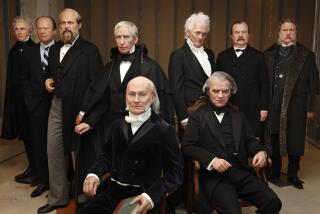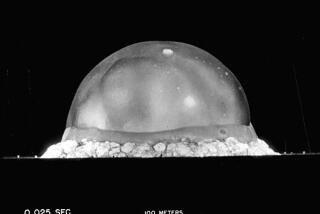The Founding Fathers’ First Sons : THE GREAT TRIUMVIRATE by Merrill D. Peterson<i> (Oxford University Press: $27.95; 573 pp.) </i>
- Share via
They were America’s “second race of giants.” Entering public life with the War of 1812, they departed with the Civil War looming.
The meeting of Henry Clay, John C. Calhoun, and Daniel Webster in Congress in the year 1813 heralded a new era of American political leadership.
Washington, Jefferson, and Madison--each of whom had succeeded in his turn to the presidency--had given the nation victory in its War of Independence, the Declaration that embodied its philosophy, and the supple constitutional framework that still binds it together. Clay, Calhoun and Webster would never attain the nation’s highest office, though each aspired to and repeatedly sought it. Yet they were to dominate the next 40 years almost as completely as the Founding Fathers had dominated the previous 40. There was scarcely an issue of national import in which one, and usually all three, did not play a leading role.
At the outset the task of this second generation seemed clear: the building of a nation upon the inherited legal, political, and geographic framework. Calhoun died in 1850, Clay and Webster two years later, with the certain knowledge that the great challenge to American statesmanship was to keep this new edifice from crashing in upon itself.
Calhoun went to his grave despairing of the Union, hoping that disunion and war were not synonymous. Webster and Clay who had toasted together the compromise of 1850 died with hope that the Union could be preserved, perhaps because they understood that it could only be dissolved in blood.
In “The Great Triumvirate,” Merrill Peterson has given us a thorough and scholarly account of these three giants and the grand debates that consumed their lives. If his excellent work has a major fault, it is in understating the role of their common nemesis Andrew Jackson.
If Clay, Calhoun, and Webster became the enduring symbols of congressional leadership, Jackson was assurely the forerunner of the modern presidency. His life and legacy are almost as inextricably intertwined with theirs as theirs with each others’. If the triumvirs were, throughout the twists and turns of their careers, ever the defenders of republican government, Jackson led the triumphant vanguard of popular democracy.
As might be imagined, “Triumvirate” (almost 500 pages of text) is not to be read at a sitting. It is a nightstand book to be explored and pondered at leisure. The Jackson void can be filled by a nightstand large enough to accommodate Robert Remini’s monumental three volumes. Read Remini’s prefaces, start in on Peterson, then bounce back and forth at will.
For this layman, the continuing struggle in reading history is avoiding the distortion of omniscience. That difficulty is particularly acute with this period, ending as it did with the most grand and most terrible event in the nation’s history. Unable to escape that dreadful knowledge, it is almost impossible not to view the preceding decade from the blood-soaked perspectives of Mayres Heights, Cemetery Ridge, and Kennesaw Mountain.
But the rewards of studying this little-understood era for its own sake are worth the effort. It was the time when America, as historian Page Smith tells us, truly came of age. One finds it difficult to quarrel with Smith’s assessment that it was “the most remarkable era in American history, perhaps in the history of the world.”
The great debates on protectionism, the bank, internal improvements, nationalism, executive power, the annexation of Texas and California, and distribution of the budget surplus (yes, surplus) are fascinating on their merits. The increasingly desperate attempts to deal with the swelling cancer of slavery, how it came to dominate all other considerations of policy and politics, would enthrall and instruct even had the cure not cost 500,000 lives.
And the men, particularly the men. Any student of politics will recognize the ever-shifting, often seamless, pattern of ambition and altruism, courage and timidity, wisdom and naivete, philosophy and personality that motivated them. They were in that sense like all politicians (and all mortals), but they were also by any definition of the term “great men,” who “triangulated the destiny of the nation.”
Which brings us back to that dreadful knowledge that in the end it did not work. Neither the peaceful co-existence of Union and slavery nor peaceful dissolution proved possible. “They had failed, and the institutions had failed,” says Peterson “to perpetuate or reproduce that greatness of statesmanship. They were indeed the last of the giants.”
Perhaps. But such a conclusion can carry with it the implication that “great men” in sufficient quantity and stature can be our salvation. That seems to have been the fatal supposition of most of their countrymen and colleagues. Probably Clay, Calhoun, and Webster believed it too.
A more modest definition of greatness may be more appropriate and less dangerous in a democracy: Great men and women can warn us of dangers yet undetected, show us unsuspected answers and alternatives, inspire us, give us hope, and buy us time; but they cannot ultimately save us from ourselves.
More to Read
Sign up for Essential California
The most important California stories and recommendations in your inbox every morning.
You may occasionally receive promotional content from the Los Angeles Times.













